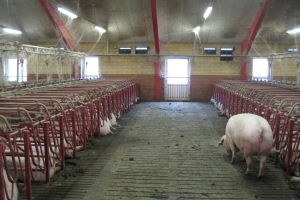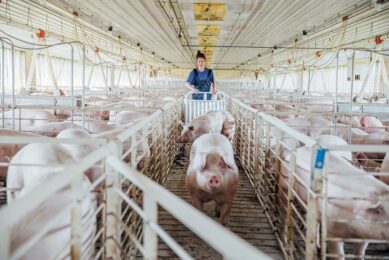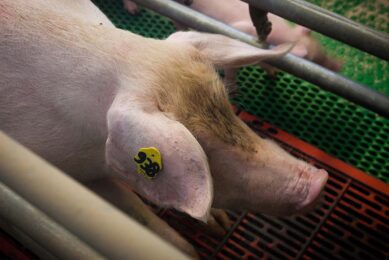Swine management changes with switch to group housing

Swine producers need to take an animal-directed approach that involves spending more time observing pigs and learning their social behaviour, as well as understanding their locomotion characteristics and possible injuries within the group-housing system.
That was the message of Marrina Schuttert, DVM, Veterinair Centrum Someren, the Netherlands, in a press release by the Feet First Team, an international collaboration of researchers, veterinarians and nutritionists and supported by Zinpro Performance Minerals.
The management skills of swine producers throughout the European Union will be put to the test beginning January 1, 2013, with the mandated move away from gestation-sow stalls to group housing. Swine-welfare experts predict 18 of the EU’s 27 pig-producing countries will meet the group-housing deadline.
Animal observation
Swine producers must rely more heavily on animal observation and management with the new system. In group housing, technical features can’t compensate for lack of skills. As Schuttert points out, “It’s the person, not the system.”
According to Schuttert, swine producers need to take an animal-directed approach that involves spending more time observing pigs and learning their social behaviour, as well as understanding their locomotion characteristics and possible injuries within the group-housing system.
Concern over animal welfare is very strong in the Netherlands and drives legislation mandating everything in swine production from pollution limits and the size of operations to the amount of space needed for each pig and the use of antibiotics.
Focus on gilt development
For instance, the Netherlands mandates that sows will have only 4 days of crate time after insemination before moving to group housing. That makes it imperative that gilts are mature, confident and acclimated to make the move.
“We take gilt rearing seriously,” Schuttert points out. “We manage them separately by feeding for optimal growth rate and by providing optimized nutrition for internal organ and skeletal development.” She recommends an average daily gain for developing gilts of 750 g/day, slower than the average of 850 g/day in finishing pigs.
Another important aspect of gilt development is training or acclimating gilts to the new environment they will face as sows. “By training the gilt into the production system, you let her know what to expect in terms of the feeding plan, flooring options and interactions with other sows in a group setting,” Schuttert explains — a simple process that provides a young gilt a good start within the herd and helps ensure her chances of longevity in the sow herd.
Group housing and lameness
According to Schuttert, in group housing it is important for producers to understand lesion-scoring systems for sow feet and to take the time to observe the sows for lameness. Two types of injuries are most common in group housing — hoof cracks and coronary-band injuries.
The new group housing system requires 2.25 m2 per sow with 40% of that being solid flooring. While solid flooring plays an important role in preventing claw injuries, the width of the slats in the remaining portion of the floor also plays a major role in coronary-band injuries. When the space between slats is too wide, the foot sinks between the slats, abrading and stressing the coronary band.
Under wet floor conditions, manure and urine hanging in the claws can increase infection through lesions and abrasions in the coronary-band area where the hoof meets the hair line. While coronary-band lesions may not be the most commonly observed injury, they have the greatest impact on sow welfare and are directly responsible for higher culling numbers, Schuttert reports.
Claw lesions offer a different prognosis. “When we see an increase in horizontal and vertical cracks, we look at two major areas,” Schuttert explains. “First is introduction into the group. Are young sows having a lot of physical contact with bigger sows and injuring themselves? Second, are we feeding the sows properly? Adding complexed minerals to the diet improves claw growth and helps produce a strong and elastic, good-quality claw.”
Focus on management
A recent study involving 700 Dutch swine producers who moved sows into group housing at four days versus four weeks following insemination found that the farrowing rate was not dependent on the time at which the sows entered group housing. Dutch legislation mandates 4 days of crate time following insemination compared to 4 weeks allowed in the EU regulations.
With Dutch swine producers weaning an average of 28.8 pigs and the highest-producing sows delivering more than 33 pigs/ sow/ year, the results of the study show it is possible to have very good production results in group-housing systems.
Mindset
The move to group housing requires not only a change in facilities but also a change in mindset and management. “The human-management factor becomes more important in group housing,” Schuttert stresses. The management approach in training workers into the group-housing system must be easy and simple, especially if language barriers are involved. Well-trained employees are crucial to the pig’s welfare and production level.
By using an animal-directed approach and putting the gilt’s welfare first, group housing can be a successful production system. But it requires adaptation time for new gilts entering the system, improving management and observation skills by employees, and feeding a balanced diet that offers complexed trace minerals for strong bones, connective tissue and claws.
Related news item:
• Zinpro Performance Minerals











